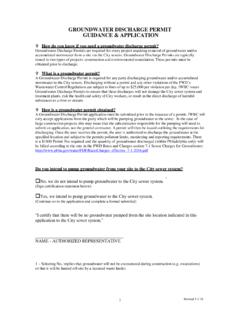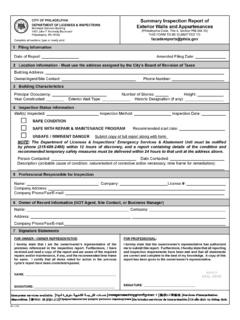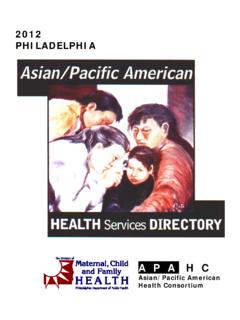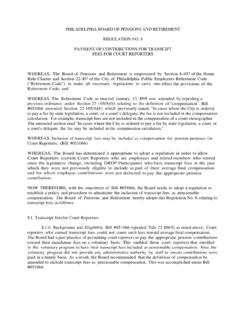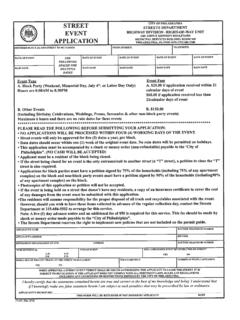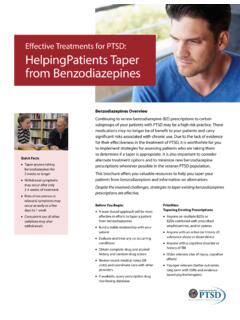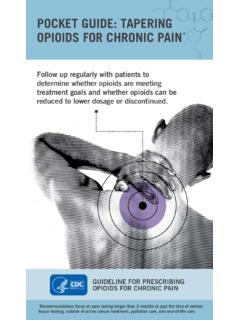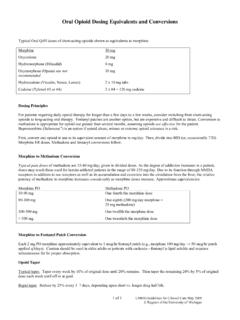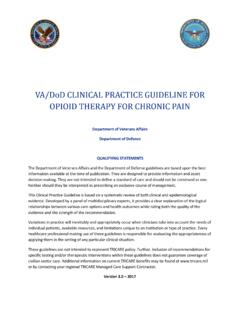Transcription of POSTOPERATIVE OPIOID PRESCRIBING GUIDELINES
1 In the past, surgeons and other physicians were strongly encouraged to treat pain aggressively with opioids. It is now clear that the PRESCRIBING of opioids leads too often to side effects, dependence and addiction. At the same time, studies have shown that NSAIDS are as effective as opioids for treating many forms of pain, including acute POSTOPERATIVE pain. These GUIDELINES , which are based on studies of analgesic needs postoperatively, attempt to balance the benefits and risks of opioids. They recommend: Managing patient expectations about pain after surgery Maximizing the use of non- OPIOID pain treatments pre- and postoperatively Avoiding the use of opioids for minor surgical procedures Sharply limiting the duration of OPIOID use following major surgical procedures POSTOPERATIVE OPIOID PRESCRIBING GUIDELINESP reoperative and Intraoperative Management of PainUnless contraindicated, patients should take analgesic medications (such as NSAIDS, acetaminophen, gabapentin) on a scheduled basis preoperatively.
2 Consideration should be given to the applicability of following intraoperative medications and techniques, all of which have been shown to reduce the requirement for opioids1: Neuraxial or peripheral nerve blocks Ketamine Clonidine Dexmedetomidine DexamethasoneNon- OPIOID Treatments for PainThere are many effective and far safer alternatives to opioids for treating pain. In the absence of contraindications, the following treatments should be first-line for patients following all surgeries:Non- OPIOID Non-Pharmacologic Pharmacologic Treatments TreatmentsNSAIDS Physical therapyAcetaminophen Cognitive behavioral therapyAntidepressants AcupunctureTopical medications TENS unitsNeuromodulating medications Ice, elevation, compressionPostoperatively, oral medications should be initially taken on a scheduled basis in order to maximize pain and E-PrescribingSurgeons may be concerned about under-treatment of pain, leading to requests for refills of OPIOID prescriptions.
3 However, a study of over 25,000 patients has shown that requests for OPIOID refills do not differ between patients prescribed between 8 and 60 If OPIOID prescription refills are needed, they are more easily done through e- PRESCRIBING . These GUIDELINES presume e- PRESCRIBING availability. E- PRESCRIBING of controlled substances will be required in Pennsylvania in PATIENT E XPEC TATIONSB efore surgery, discuss with patients the pain they may expect to have after the procedure. Patients should be counseled that: Pain immediately after surgery is normal and an expected part of the healing process. Pain is worst in the first 1-2 days after surgery, but improves over time. Most pain can be effectively managed with medicines other than opioids, such as NSAIDS, acetaminophen, gabapentin and topicals.
4 If opioids are being prescribed: Opioids should be used only when other medicines have not adequately treated severe pain, and should be stopped when the pain is manageable with non- OPIOID pain medications or alternative strategies. Opioids should be taken in addition to, not in place of, non- OPIOID pain medications in order to minimize the amount of opioids taken. Opioids carry a high risk of physical dependence, addiction and overdose. Unused opioids should be disposed of safely to prevent misuse or diversion. GUIDELINES FOR OPIOID -NA VE PATIENTSS pecialtyNumber of Pills* Recommended for OPIOID -Naive Patients at Discharge (minimum maximum)Minor procedureMajor procedure General, Colorectal, Gynecologic Oncology, Plastic06 (0 13)4 Orthopedic, Neurosurgery09 (0 18)4,5 Cardiothoracic, Vascular09 (0 18)4OB/Gyn06 (0 12)6 Urologic04 (0 8)7 OMFS, ENT05 (0 9)8* pill = 1 tab of 5mg oxycodone or equivalent MME in short-acting OPIOID For patients discharged after post-op day 1, use of opioids in the 24 hours before discharge can further guide the amount prescribed.
5 For patients requiring no opioids the day before discharge, no prescription is likely needed. Minor procedureMajor procedureENT and Oral Surgery Tooth extraction Tonsillectomy Thyroidectomy Maxillary or mandibular osteotomy Resection of large benign or malignant mass requiring overnight hospital stayGeneral Surgery Breast lumpectomy or mastectomy with or without LN biopsy or axillary dissection Laparoscopic cholecystectomy Inguinal herina repair Soft tissue mass removal Hemorrhoidectomy Mastectomy with immediate tissue reconstruction Open repair or resection of stomach, small bowel, colon, liver, pancreas, adrenal or liver Open cholecystectomyGynecology Dilation and curettage Tubal ligation Laparoscopy limited endometriosis Hysteroscopic resection or ablation Abdominal or transvaginal pelvic floor surgeryUrology Cystoscopy, ureteroscopy Vasectomy Resection of bladder or prostate tumorNeurosurgery and Spine Surgery Discectomy Intracranial surgery Spinal laminectomy and/or fusionOrthopedic Surgery Shoulder arthroscopy Knee arthroscopy Tendon repair Hardware removal Arthroplasty (knee, hip, shoulder)
6 ORIF of long bones BunionectomyPlastic Surgery Carpal tunnel release Lipoma excision Cosmetic breast surgery Free flap reconstruction PanniculectomyCardiothoracic Surgery Mediastinoscopy Resection of lung, esophagus, or mediastinal massVascular Surgery Varicose vein excision Aortic aneurysm repairEXAMPLES OF MINOR AND MAJOR PROCEDURES9 All outpatient procedures should be considered minor FOR PATIENTS WITH CHRONIC OPIOID USE Do not increase opioids above preoperative levels. Before surgery, set expectations for anticipated pain, healing time and POSTOPERATIVE OPIOID use. Consult patient s pain management or pain medication prescriber prior to surgery to establish a POSTOPERATIVE plan. If surgery was performed to address chronic pain (such as arthroplasty for end-stage osteoarthritis), consider taper as soon as acute pain is expected to resolve.
7 If surgery did not address cause of chronic pain, consider slow taper and discuss with patient s PRESCRIBING Philadelphia Department of Public Health s Tapering GUIDELINES for Monroe H. (2015). Non- OPIOID analgesics in orthopedic surgery. In M. Anderson, S. Wilson, & M. Rosenblatt (Eds), Decision-Making in Orthopedic and Regional Anesthesiology: A Case-Based Approach ( ). Cambridge: Cambridge University Sekhri S, Arora NS, Cottrell H et al. Probability of OPIOID Prescription Refilling After Surgery: Does Initial Prescription Dose Matter? Ann Surg. 2018 Aug;268(2) Act 96. Retrieved 11/5/18. Available at: Thiels CA, Ubl DS, Yost KJ et al. Results of a Prospective, Multicenter Initiative Aimed at Developing OPIOID - PRESCRIBING GUIDELINES After Surgery. Ann Surg. 2018 Sep;268(3) Kim N, Matzon JL, Abbdoudi J et al.
8 A Prospective Evaluation of OPIOID Utilization After Upper-Extremity Surgical Procedures: Identifying Consumption Patterns and Determining PRESCRIBING GUIDELINES . J Bone Joint Surg Am. 2016 Oct 19;98(20) Bartels K, Mayes LM, Dingmann C et al. OPIOID Use and Storage Patterns by Patients after Hospital Discharge following Surgery. PLoS ONE 11(1): Bates C, Laciak R, Southwick A et al. Overprescription of POSTOPERATIVE Narcotics: A Look at POSTOPERATIVE Pain Medication Delivery, Consumption and Disposal in Urological Practice. J Urol. 2011 Feb;185(2) Gray ML, Fan CJ, Kappauf C, et al. POSTOPERATIVE pain management after sinus surgery: a survey of the American Rhinologic Society. Int Forum Allergy Rhinol. 2018;8:1199 Adapted from the Winnipeg Regional Health Authority, 201610.
9 Available at: HealthC ITY OF PHILADELPHIAD epartment of
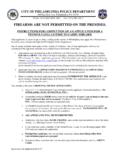
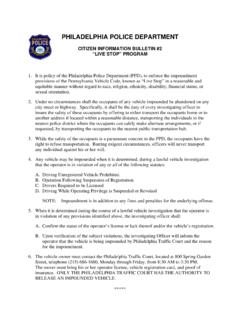
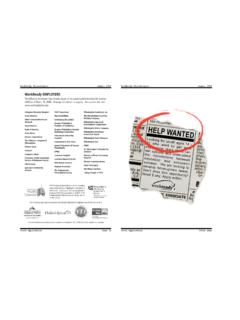
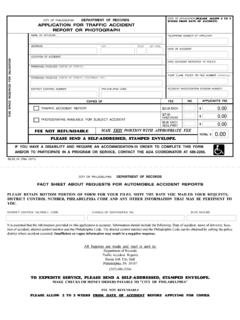
![[PSA] Philly: Classaction lawsuit brings changes in …](/cache/preview/1/4/c/8/8/d/5/c/thumb-14c88d5c5b2f1fee5e561fc7daceb397.jpg)
